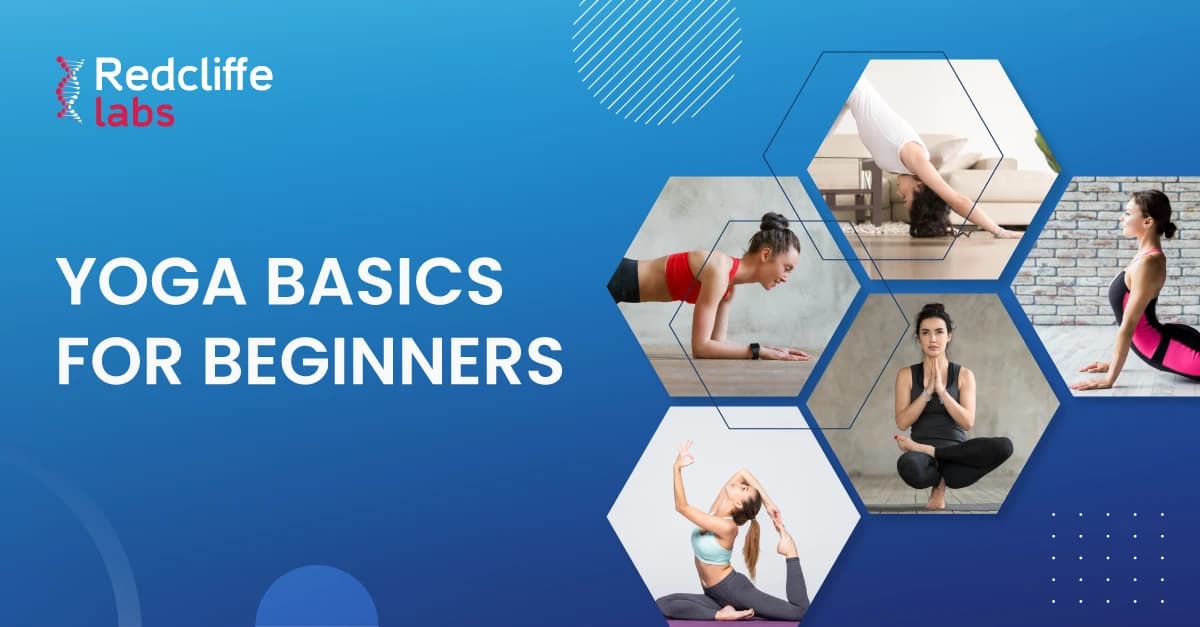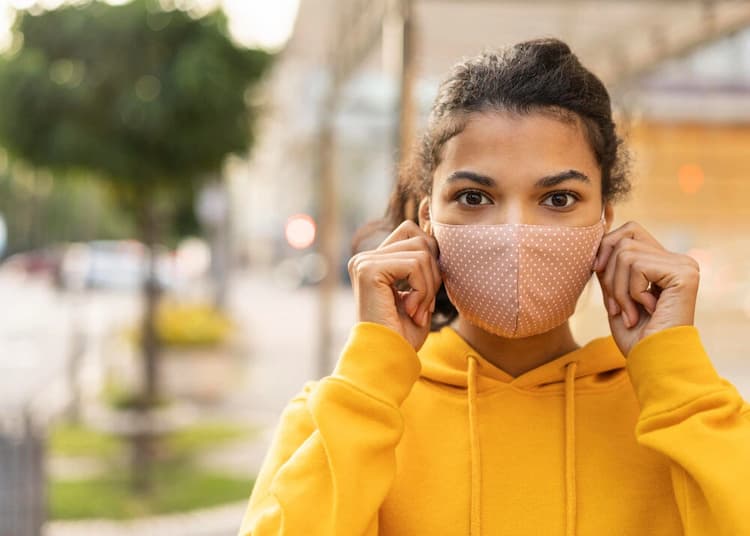Yoga: Physical and Mental Well-Being For Everyone- The Beginner's Guide

Medically Reviewed By
Dr Divya Rohra
Written By Prekshi Garg
on Jun 8, 2022
Last Edit Made By Prekshi Garg
on Mar 12, 2024

Whether your physique is bothering you or you are stressed out mentally, it's time to roll out your yoga mat. The blog underneath is an in-detail Yoga Guide For Beginners. If you are confused about where to begin, we offer you the most appropriate solution.
Yoga: How the Beginners Can Begin With The Yoga Practice?
Yoga is an age-old practice for the mental and physical wellness of the young and the old. Irrespective of your age and weight, yoga has the power to benefit you. Once you start dedicating your time regularly to yoga, you can expect a strengthening of your body and calmness in your mind. However, one of the essential things about yoga is consistency and the correct postures (popularly referred to as Yoga Asanas).
Top 5 Yoga Asanas That Every Beginner Should Know:
Yoga Poses are the building blocks as you begin practising this exercise. These 5 yoga postures or asanas can help initiate a full-body workout for beginners. Well, before you begin the yoga practice, you mustn't overexercise on the very first day. It is recommended to take the pace slowly. Along with the poses, managing the breath is essential during Yoga. The first tip of Yoga For Beginners is to inhale and exhale properly while exercising. If at any point you feel that you are short of breath, you must take a pause and then start afresh once you start breathing again at an average pace.
Yoga Postures For Beginners:
-
Child’s Pose:
 It is one of the best poses to stretch and relax your body. Begin the posture by sitting in vajrasana. Now, take a deep breath and stretch your arms upright. The next step is to exhale and bend forward. Focus: While practising this yoga posture, focus on your lower back and spine and ensure it does not pressure your knees. Benefits: It helps gently stretch your back, knees, and ankle and relax your spine. Who Can Do It? If you want to relax your lower back, spine, hips, and shoulders. Who Should Avoid? If you suffer knee issues, ankle related problems, high blood pressure, or pregnancy, avoid practising this yoga asana. Yoga Tip For Beginners: Use a cushion under your head and ankles if you feel uncomfortable.
It is one of the best poses to stretch and relax your body. Begin the posture by sitting in vajrasana. Now, take a deep breath and stretch your arms upright. The next step is to exhale and bend forward. Focus: While practising this yoga posture, focus on your lower back and spine and ensure it does not pressure your knees. Benefits: It helps gently stretch your back, knees, and ankle and relax your spine. Who Can Do It? If you want to relax your lower back, spine, hips, and shoulders. Who Should Avoid? If you suffer knee issues, ankle related problems, high blood pressure, or pregnancy, avoid practising this yoga asana. Yoga Tip For Beginners: Use a cushion under your head and ankles if you feel uncomfortable.
-
Plank Position:
 Plank is the yoga posture that helps strengthen your core and shed those extra inches from your belly. It is a primary pushup position, wherein you have to hold the position. The beginners can start it with 20 to 30 seconds, and then slowly; you can extend the duration. Make sure that you breathe regularly while holding the position. Focus: This Yoga Posture strengthens your core, shoulder, arms, and legs. Benefits: It helps to enhance body balancing and concentration. Who Can Do It? Plank is a good Yoga Posture For Beginners looking forward to toning their abs and strengthening the upper body. Who Should Avoid It? Avoid this yoga posture if you have lower back pain or carpal tunnel syndrome. Yoga Tip For Beginners: You can modify the posture by touching your knees on the floor if the plank pose is too challenging.
Plank is the yoga posture that helps strengthen your core and shed those extra inches from your belly. It is a primary pushup position, wherein you have to hold the position. The beginners can start it with 20 to 30 seconds, and then slowly; you can extend the duration. Make sure that you breathe regularly while holding the position. Focus: This Yoga Posture strengthens your core, shoulder, arms, and legs. Benefits: It helps to enhance body balancing and concentration. Who Can Do It? Plank is a good Yoga Posture For Beginners looking forward to toning their abs and strengthening the upper body. Who Should Avoid It? Avoid this yoga posture if you have lower back pain or carpal tunnel syndrome. Yoga Tip For Beginners: You can modify the posture by touching your knees on the floor if the plank pose is too challenging.
-
Four-Limbed Staff Pose:
 The four-limbed staff pose is an extended variation of the plank position. You only have to fold your arms at 90 degrees from the shoulder in this position. It is a more advanced yoga posture beneficial when you wish to practice arm balancing and inversions. Focus: When you practise this yoga asana, your focus shall be on balancing the arms, and it does not drain out your back. Benefits: Alike Plank, the four-limbed staff pose helps flatten or tone your abdomen and strengthen the arms, shoulder, and wrist. Who Can Do It? If you are healthy without any medical history and need to work on your abdomen and arms, this yoga posture can help you gain results. Who Should Avoid It? Avoid doing a four-limbed staff pose during pregnancy, shoulder or arm injury, lower back pain or carpal tunnel syndrome. Yoga Tip For Beginners: The beginners have the flexibility to modify their posture by placing their knees on the floor.
The four-limbed staff pose is an extended variation of the plank position. You only have to fold your arms at 90 degrees from the shoulder in this position. It is a more advanced yoga posture beneficial when you wish to practice arm balancing and inversions. Focus: When you practise this yoga asana, your focus shall be on balancing the arms, and it does not drain out your back. Benefits: Alike Plank, the four-limbed staff pose helps flatten or tone your abdomen and strengthen the arms, shoulder, and wrist. Who Can Do It? If you are healthy without any medical history and need to work on your abdomen and arms, this yoga posture can help you gain results. Who Should Avoid It? Avoid doing a four-limbed staff pose during pregnancy, shoulder or arm injury, lower back pain or carpal tunnel syndrome. Yoga Tip For Beginners: The beginners have the flexibility to modify their posture by placing their knees on the floor.
-
Downward Facing Dog:
 It is one of the popular asanas of Yoga For Beginners. It has multiple benefits and is not that difficult to perform. The position requires placing your limbs (Both feet and arms) on the floor while making an arch of your back. Focus: On the entire body Benefits: Downward Facing Dog Yoga Asana helps strengthen your arms, back, hamstrings, calves, and feet. Who Should Do It? If you have back pain or a consistent seating job, this posture can help you get rid of cervical problems. Also, it can wave off additional fat from your back, hamstring, thighs, hips, and calves. Who Should Avoid It? If you are in the late stages of pregnancy, avoid practising this yoga pose. This asana is not for you if you have high blood pressure, arms, and wrist issues. Yoga Tip For Beginners: To avoid any kind of sprain, divide your weight equally on both palms. Maintain the proper shoulder length distance between the two arms, and keep your hips towards the back, i.e., away from the shoulders.
It is one of the popular asanas of Yoga For Beginners. It has multiple benefits and is not that difficult to perform. The position requires placing your limbs (Both feet and arms) on the floor while making an arch of your back. Focus: On the entire body Benefits: Downward Facing Dog Yoga Asana helps strengthen your arms, back, hamstrings, calves, and feet. Who Should Do It? If you have back pain or a consistent seating job, this posture can help you get rid of cervical problems. Also, it can wave off additional fat from your back, hamstring, thighs, hips, and calves. Who Should Avoid It? If you are in the late stages of pregnancy, avoid practising this yoga pose. This asana is not for you if you have high blood pressure, arms, and wrist issues. Yoga Tip For Beginners: To avoid any kind of sprain, divide your weight equally on both palms. Maintain the proper shoulder length distance between the two arms, and keep your hips towards the back, i.e., away from the shoulders.
-
Cobra Pose:
 It is one of the simplest yoga postures helping to strengthen your back. Cobra Pose not only help you to strengthen your back, but this Yoga For Beginners is also helpful when you want to pull off sprains after your exercise. Focus: Keep focusing on your back while you breathe in and out. Benefits: Cobra Pose help add spinal flexibility while firming up your arms and shoulders. Who Should Do It? To start the exercise, and when you feel your muscles are stressed up after carrying heavy weights or sitting all together for prolonged periods. Who Should Avoid It? One must skip this yoga pose in case of arthritis, spine injury, or carpal tunnel syndrome. Yoga Tip For Beginners: Uphold your belly button above the floor when you start practising this yoga asana.
It is one of the simplest yoga postures helping to strengthen your back. Cobra Pose not only help you to strengthen your back, but this Yoga For Beginners is also helpful when you want to pull off sprains after your exercise. Focus: Keep focusing on your back while you breathe in and out. Benefits: Cobra Pose help add spinal flexibility while firming up your arms and shoulders. Who Should Do It? To start the exercise, and when you feel your muscles are stressed up after carrying heavy weights or sitting all together for prolonged periods. Who Should Avoid It? One must skip this yoga pose in case of arthritis, spine injury, or carpal tunnel syndrome. Yoga Tip For Beginners: Uphold your belly button above the floor when you start practising this yoga asana.
Yoga For Beginners- Easy Exercise to Begin at Home
While for all other forms of exercise, wherein you ought to step out of home, for yoga, you just have to open up your doors and windows, breathe in the fresh air, and start. Moreover, there are no side effects of yoga and be it an adult or a child; everyone can practise it. However, do not pick up the pace in the very beginning. Take some time to understand the yoga postures, and start practising slowly with proper breathing. You can take the help of a trainer in the beginning or browse videos over the web. Moreover, there are no hefty fees to start this form of daily exercise. All you need is a yoga mat and motivation to make this healthy deed part of your routine. Stay Tuned For More Updates and To Learn About a Healthy Lifestyle.



